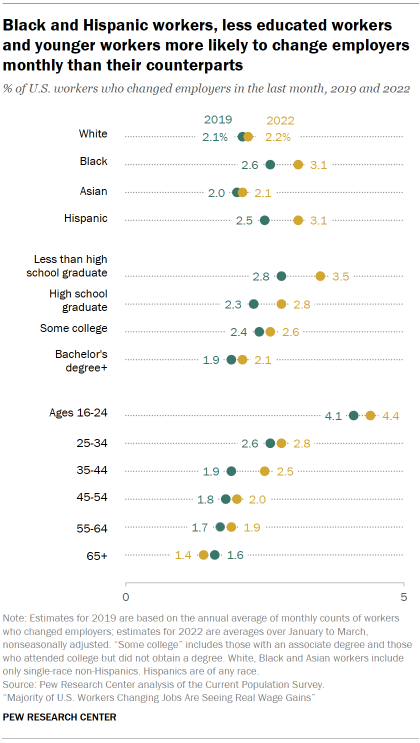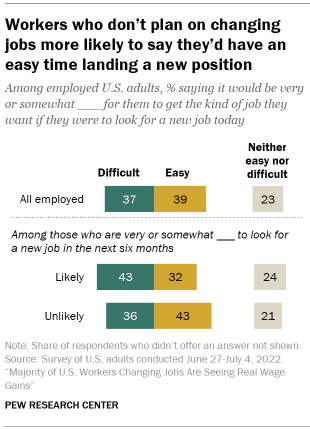Rubén Weinsteiner
TikTok
has established itself as one of the top online platforms for U.S.
teens, while the share of teens who use Facebook has fallen sharply
How we did this 
The landscape of social media is ever-changing, especially among teens who often are on the leading edge
of this space. A new MARCA POLITICA survey of American teenagers ages
13 to 17 finds TikTok has rocketed in popularity since its North American debut several years ago
and now is a top social media platform for teens among the platforms
covered in this survey. Some 67% of teens say they ever use TikTok, with
16% of all teens saying they use it almost constantly. Meanwhile, the
share of teens who say they use Facebook, a dominant social media
platform among teens in the Center’s 2014-15 survey, has plummeted from 71% then to 32% today.
YouTube
tops the 2022 teen online landscape among the platforms covered in the
Center’s new survey, as it is used by 95% of teens. TikTok is next on
the list of platforms that were asked about in this survey (67%),
followed by Instagram and Snapchat, which are both used by about
six-in-ten teens. After those platforms come Facebook with 32% and
smaller shares who use Twitter, Twitch, WhatsApp, Reddit and Tumblr.1
Changes
in the social media landscape since 2014-15 extend beyond TikTok’s rise
and Facebook’s fall. Growing shares of teens say they are using
Instagram and Snapchat since then. Conversely, Twitter and Tumblr saw
declining shares of teens who report using their platforms. And two of
the platforms the Center tracked in the earlier survey – Vine and
Google+ – no longer exist.
There are some notable demographic
differences in teens’ social media choices. For example, teen boys are
more likely than teen girls to say they use YouTube, Twitch and Reddit,
whereas teen girls are more likely than teen boys to use TikTok,
Instagram and Snapchat. In addition, higher shares of Black and Hispanic
teens report using TikTok, Instagram, Twitter and WhatsApp compared
with White teens.2
This
study also explores the frequency with which teens are on each of the
top five online platforms: YouTube, TikTok, Instagram, Snapchat and
Facebook. Fully 35% of teens say they are using at least one of them
“almost constantly.” Teen TikTok and Snapchat users are particularly
engaged with these platforms, followed by teen YouTube users in close
pursuit. A quarter of teens who use Snapchat or TikTok say they use
these apps almost constantly, and a fifth of teen YouTube users say the
same. When looking at teens overall, 19% say they use YouTube almost
constantly, 16% say this about TikTok, and 15% about Snapchat. 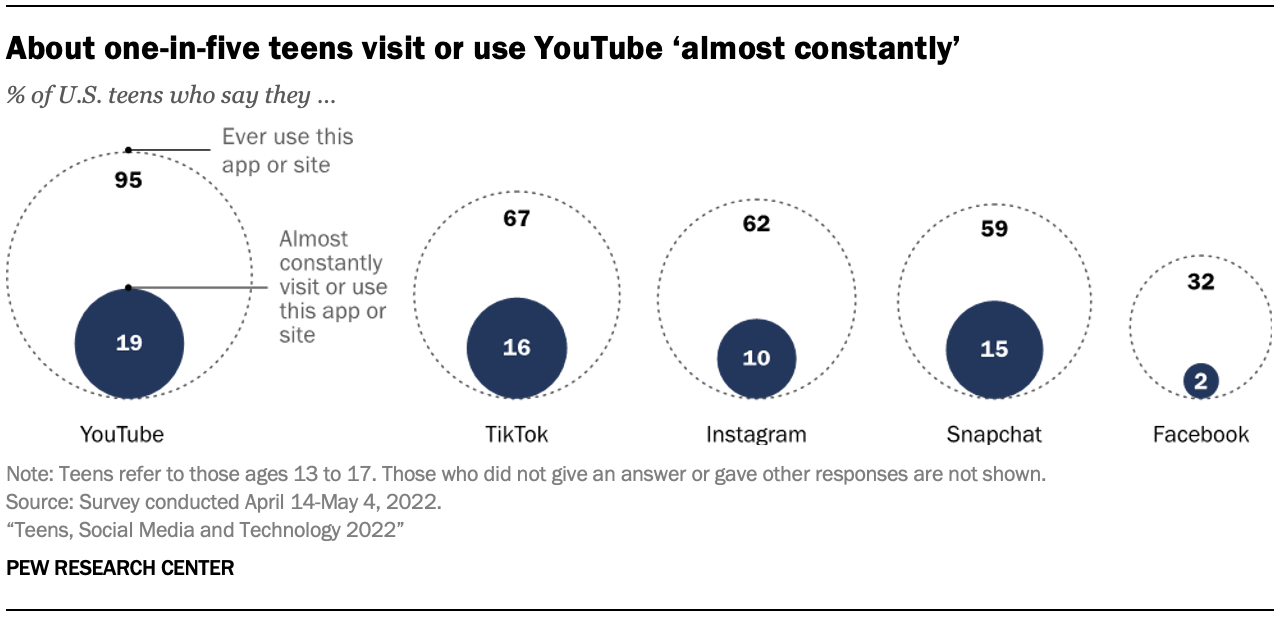

When
reflecting on the amount of time they spend on social media generally, a
majority of U.S. teens (55%) say they spend about the right amount of
time on these apps and sites, while about a third of teens (36%) say
they spend too much time on social media. Just 8% of teens think they
spend too little time on these platforms.
Asked about the idea
of giving up social media, 54% of teens say it would be at least
somewhat hard to give it up, while 46% say it would be at least somewhat
easy. Teen girls are more likely than teen boys to express it would be
difficult to give up social media (58% vs. 49%). Conversely, a quarter
of teen boys say giving up social media would be very easy, while 15% of
teen girls say the same. Older teens also say they would have
difficulty giving up social media. About six-in-ten teens ages 15 to 17
(58%) say giving up social media would be at least somewhat difficult to
do. A smaller share of 13- to 14-year-olds (48%) think this would be
difficult.
Beyond just online platforms, the new survey finds
that the vast majority of teens have access to digital devices, such as
smartphones (95%), desktop or laptop computers
(90%) and gaming consoles (80%). And the study shows there has been an
uptick in daily teen internet users, from 92% in 2014-15 to 97% today.
In addition, the share of teens who say they are online almost
constantly has roughly doubled since 2014-15 (46% now and 24% then).
These
are some of the findings from an online survey of 1,316 teens conducted
by the Pew Research Center from April 14 to May 4, 2022. More details
about the findings on adoption and use of digital technologies by teens
are covered below.
Smartphones, desktop and laptop computers, and gaming consoles remain widely accessible to teens 
Since
2014-15, there has been a 22 percentage point rise in the share of
teens who report having access to a smartphone (95% now and 73% then).
While teens’ access to smartphones has increased over roughly the past
eight years, their access to other digital technologies, such as desktop
or laptop computers or gaming consoles, has remained statistically
unchanged.
The survey shows there are differences in access to
these digital devices for certain groups. For instance, teens ages 15 to
17 (98%) are more likely to have access to a smartphone than their 13-
to 14-year-old counterparts (91%). In addition, teen boys are 21 points
more likely to say they have access to gaming consoles than teen girls –
a pattern that has been reported in prior Center research.3 
Access
to computers and gaming consoles also differs by teens’ household
income. U.S. teens living in households that make $75,000 or more
annually are 12 points more likely to have access to gaming consoles and
15 points more likely to have access to a desktop or laptop computer
than teens from households with incomes under $30,000. These gaps in
teen computer and gaming console access are consistent with digital divides by household income the Center has observed in previous teen surveys.
While
72% of U.S. teens say they have access to a smartphone, a computer and a
gaming console at home, more affluent teens are particularly likely to
have access to all three devices. Fully 76% of teens that live in
households that make at least $75,000 a year say they have or have
access to a smartphone, a gaming console and a desktop or laptop
computer, compared with smaller shares of teens from households that
make less than $30,000 or teens from households making $30,000 to
$74,999 a year who say they have access to all three (60% and 69% of
teens, respectively).
Almost all U.S. teens report using the internet daily 
The
share of teens who say they use the internet about once a day or more
has grown slightly since 2014-15. Today, 97% of teens say they use the
internet daily, compared with 92% of teens in 2014-15 who said the same.
In addition, the share of teens who say they use the internet
almost constantly has gone up: 46% of teens say they use the internet
almost constantly, up from only about a quarter (24%) of teenagers who
said the same in 2014-15. 
Black
and Hispanic teens stand out for being on the internet more frequently
than White teens. Some 56% of Black teens and 55% of Hispanic teens say
they are online almost constantly, compared with 37% of White teens. The
difference between Hispanic and White teens on this measure is
consistent with previous findings when it comes to frequent internet use.
In
addition, older teens are more likely to be online almost constantly.
Some 52% of 15- to 17-year-olds say they use the internet almost
constantly, while 36% of 13- to 14-year-olds say the same. Another
demographic pattern in “almost constant” internet use: 53% of urban
teens report being online almost constantly, while somewhat smaller
shares of suburban and rural teens say the same (44% and 43%,
respectively).
Slight differences are seen among those who say
they engage in “almost constant” internet use based on household income.
A slightly larger share of teens from households making $30,000 to
$74,999 annually report using the internet almost constantly, compared
with teens from homes making at least $75,000 (51% and 43%,
respectively). Teens who live in households making under $30,000 do not
significantly differ from either group.
The social media landscape has shifted
This
survey asked whether U.S. teens use 10 specific online platforms:
YouTube, TikTok, Instagram, Snapchat, Facebook, Twitter, Twitch,
WhatsApp, Reddit and Tumblr.
YouTube stands out as the most
common online platform teens use out of the platforms measured, with 95%
saying they ever use this site or app. Majorities also say they use
TikTok (67%), Instagram (62%) and Snapchat (59%). Instagram and Snapchat
use has grown since asked about in 2014-15, when roughly half of teens
said they used Instagram (52%) and about four-in-ten said they used
Snapchat (41%). 
The
share of teens using Facebook has declined sharply in the past decade.
Today, 32% of teens report ever using Facebook, down 39 points since
2014-15, when 71% said they ever used the platform. Although today’s
teens do not use Facebook as extensively as teens in previous years, the
platform still enjoys widespread usage among adults, as seen in other recent Center studies.
Other
social media platforms have also seen decreases in usage among teens
since 2014-15. Some 23% of teens now say they ever use Twitter, compared
with 33% in 2014-15. Tumblr has seen a similar decline. While 14% of
teens in 2014-15 reported using Tumblr, just 5% of teens today say they
use this platform.
The online platforms teens flock to differ
slightly based on gender. Teen girls are more likely than teen boys to
say they ever use TikTok, Instagram and Snapchat, while boys are more
likely to use Twitch and Reddit. Boys also report using YouTube at
higher rates than girls, although the vast majority of teens use this
platform regardless of gender. 
Teens’
use of certain online platforms also differs by race and ethnicity.
Black and Hispanic teens are more likely than White teens to say they
ever use TikTok, Instagram, Twitter or WhatsApp. Black teens also stand
out for being more likely to use TikTok compared with Hispanic teens,
while Hispanic teens are more likely than their peers to use WhatsApp.
Older
teens are more likely than younger teens to say they use each of the
online platforms asked about except for YouTube and WhatsApp. Instagram
is an especially notable example, with a majority of teens ages 15 to 17
(73%) saying they ever use Instagram, compared with 45% of teens ages
13 to 14 who say the same (a 28-point gap).
Despite Facebook
losing its dominance in the social media world with this new cohort of
teens, higher shares of those living in lower- and middle-income
households gravitate toward Facebook than their peers who live in more
affluent households: 44% of teens living in households earning less than
$30,000 a year and 39% of teens from households earning $30,000 to less
than $75,000 a year say they ever use Facebook, while 27% of those from
households earning $75,000 or more a year say the same. Differences in
Facebook use by household income were found in previous Center surveys as well (however the differences by household income were more pronounced in the past). 
When
it comes to the frequency that teens use the top five platforms the
survey looked at, YouTube and TikTok stand out as the platforms teens
use most frequently. About three-quarters of teens visit YouTube at
least daily, including 19% who report using the site or app almost
constantly. A majority of teens (58%) visit TikTok daily, while about
half say the same for Snapchat (51%) and Instagram (50%).
Looking
within teens who use a given platform, TikTok and Snapchat stand out
for having larger shares of teenage users who visit these platforms
regularly. Fully 86% of teen TikTok or Snapchat users say they are on
that platform daily and a quarter of teen users for both of these
platforms say they are on the site or app almost constantly. Somewhat
smaller shares of teen YouTube users (20%) and teen Instagram users
(16%) say they are on those respective platforms almost constantly
(about eight-in-ten teen users are on these platforms daily).
Not
only is there a smaller share of teenage Facebook users than there was
in 2014-15, teens who do use Facebook are also relatively less frequent
users of the platform compared with the other platforms covered in this
survey. Just 7% of teen Facebook users say they are on the site or app
almost constantly (representing 2% of all teens). Still, about
six-in-ten teen Facebook users (57%) visit the platform daily.
Across
these five platforms, 35% of all U.S. teens say they are on at least
one of them almost constantly. While this is not a comprehensive rundown
of all teens who use any kind of online platform almost constantly,
this 35% of teens represent a group of relatively heavy platform users
and they clearly have different views about their use of social media
compared with those who say they use at least one of these platforms,
though less often than “almost constantly.” Those findings are covered
in a later section. 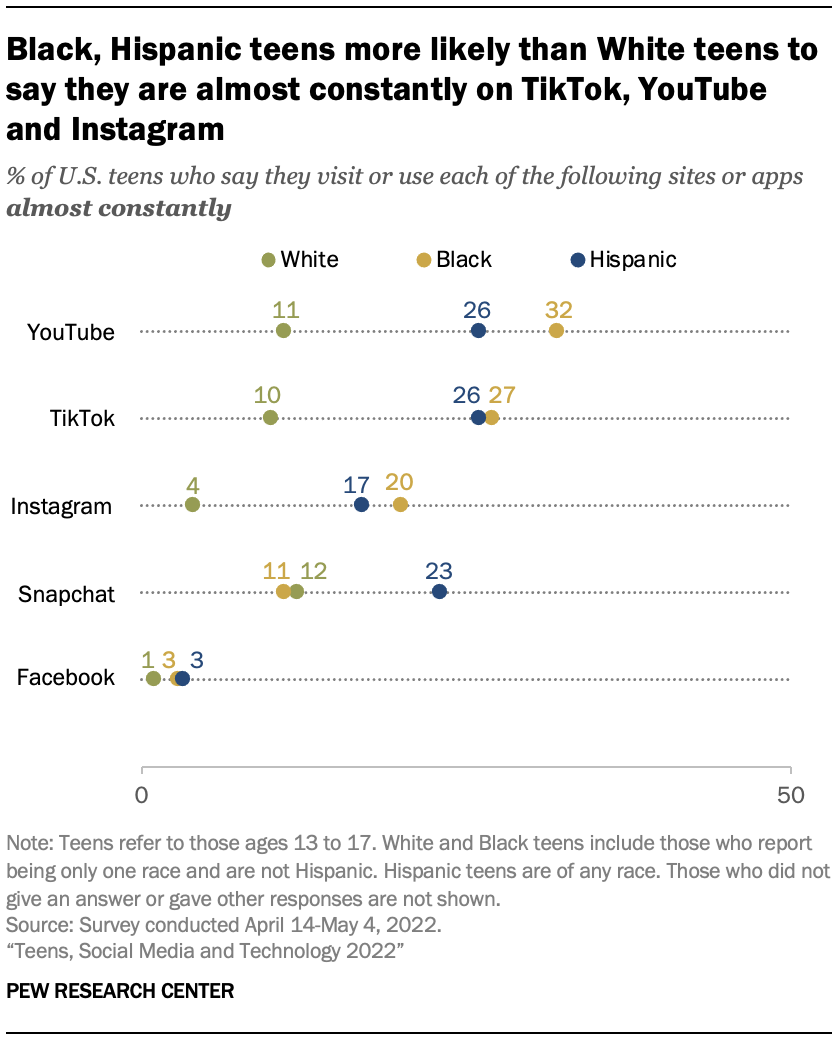
Larger
shares of Black and Hispanic teens say they are on TikTok, YouTube and
Instagram almost constantly than White teens. For example, Black and
Hispanic teens are roughly five times more likely than White teens to
say they are on Instagram almost constantly.
Hispanic teens are
more likely to be frequent users of Snapchat than White or Black teens:
23% of Hispanic teens say they use this social media platform almost
constantly, while 12% of White teens and 11% of Black teens say the
same. There are no racial and ethnic differences in teens’ frequency of
Facebook usage.
Overall, Hispanic (47%) and Black teens (45%)
are more likely than White teens (26%) to say they use at least one of
these five online platforms almost constantly.
Slight majorities of teens see the amount of time they spend on social media as about right and say it would be hard to give up 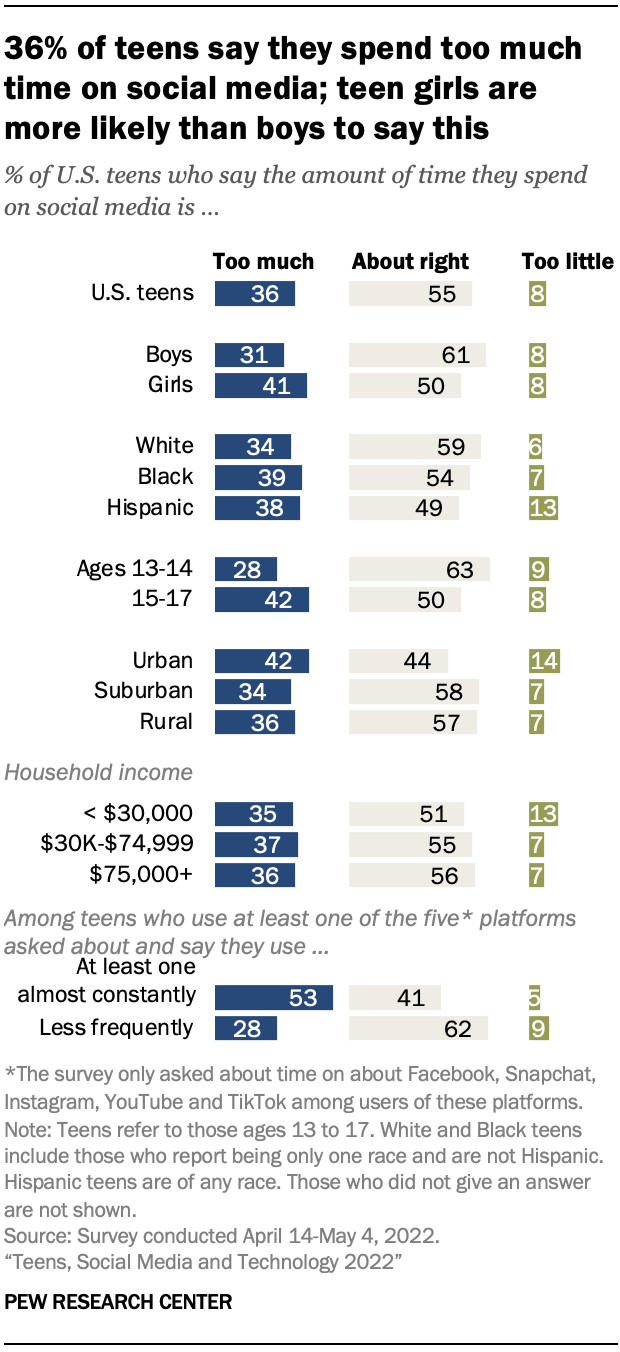
As
social media use has become a common part of many teens’ daily routine,
the Center asked U.S. teens how they feel about the amount of time they
are spending on social media. A slight majority (55%) say the amount of
time they spend of social media is about right, and smaller shares say
they spend too much time or too little time on these platforms.
While
a majority of teen boys and half of teen girls say they spend about the
right amount of time on social media, this sentiment is more common
among boys. Teen girls are more likely than their male counterparts to
say they spend too much time on social media. In addition, White teens
are more likely to see their time using social media as about right
compared with Hispanic teens. Black teens do not differ from either
group.
This analysis also explored how teens who frequently use
these platforms may feel about their time on them and how those feelings
may differ from teens who use these sites and apps less frequently. To
do this, two groups were constructed. The first group is the 35% of
teens who say they use at least one of the five platforms this survey
covered – YouTube, TikTok, Instagram, Snapchat or Facebook – almost
constantly. The other group consists of teens who say they use these
platforms but not as frequently – that is, they use at least one of
these five platforms but use them less often than “almost constantly.”
When
asked how they feel about the time they spend on social media, 53% of
teens who almost constantly use at least one of the platforms say they
are on social media too much, while about three-in-ten teens (28%) who
use at least one of these platforms but less often say the same.
Teens
who are almost constantly online – not just on social media – also
stand out for saying they spend too much time on social media: 51% say
they are on social media too much. By comparison, 26% of teens who are
online several times a day say they are on social media too much. 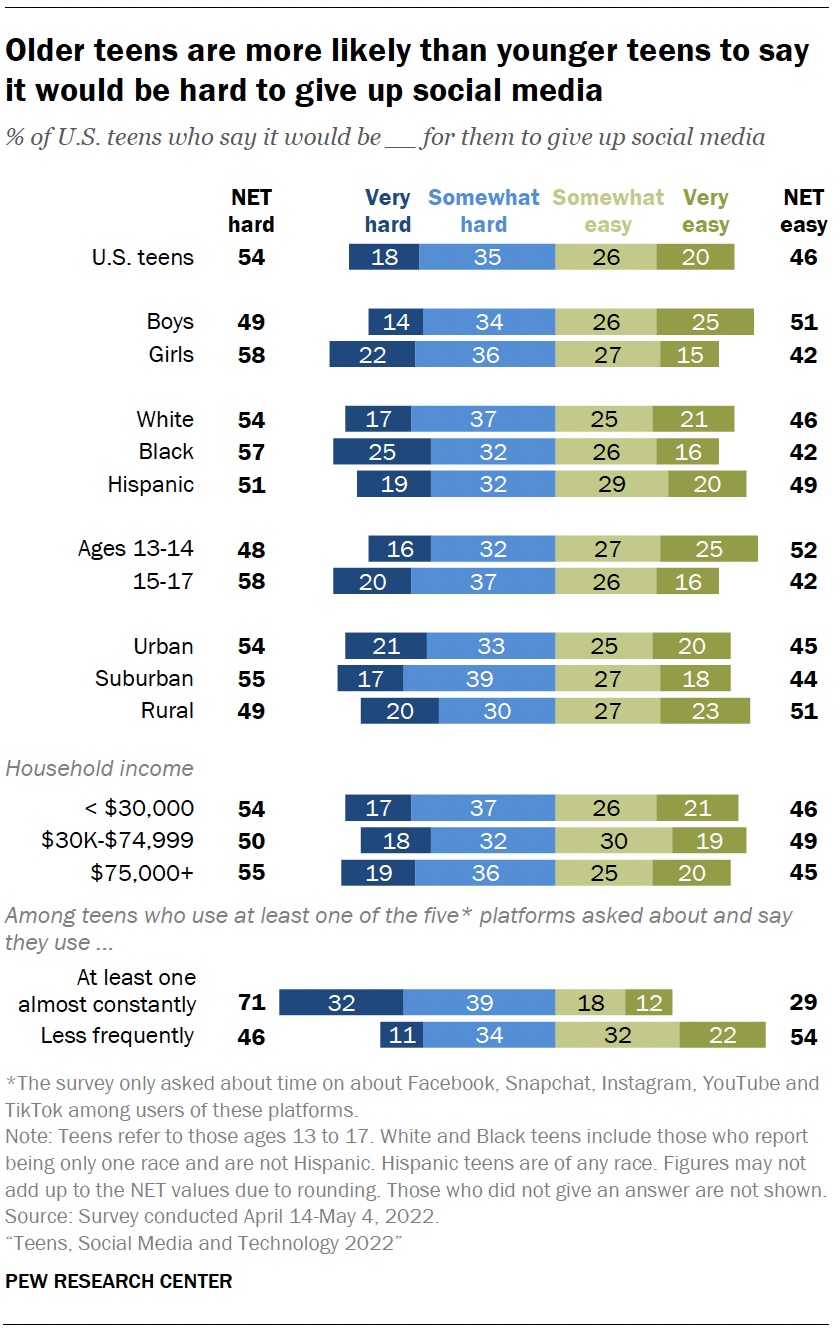
When
reflecting on what it would be like to try to quit social media, teens
are somewhat divided whether this would be easy or difficult. Some 54%
of U.S. teens say it would be very (18%) or somewhat hard (35%) for them
to give up social media. Conversely, 46% of teens say it would be at
least somewhat easy for them to give up social media, with a fifth
saying it would be very easy.
Teenage girls are slightly more
likely to say it would be hard to give up social media than teen boys
(58% vs. 49%). A similar gap is seen between older and younger teens,
with teens 15 to 17 years old being more likely than 13- and
14-year-olds to say it would be at least somewhat hard to give up social
media.
A majority of teens who use at least one of the
platforms asked about in the survey “almost constantly” say it would be
hard to give up social media, with 32% saying it would be very hard.
Smaller shares of teens who use at least one of these online platforms
but use them less often say the same.
The teens who think they
spend too much time on social media also report they would struggle to
step back completely from it. Teens who say they spend too much time on
social media are 36 percentage points more likely than teens who see
their usage as about right to say giving up social media would be hard
(78% vs. 42%). In fact, about three-in-ten teens who say they use social
media too much (29%) say it would be very hard for them to give up
social media. Conversely, a majority of teens who see their social media
usage as about right (58%) say that it would be at least somewhat easy
for them to give it up.



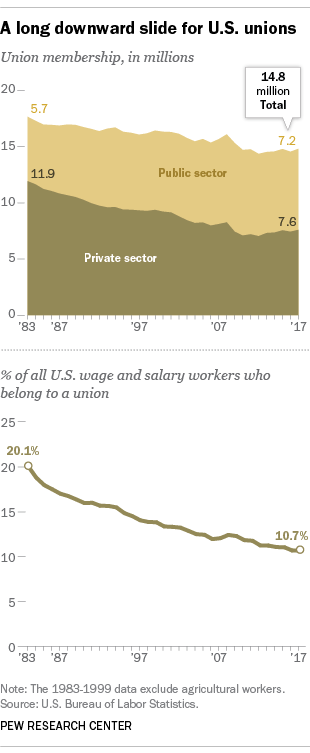 Despite
those fairly benign views, unionization rates in the United States have
dwindled in recent decades (even though, in the past few years, the
absolute number of union members has grown slightly). As of 2017, just
10.7% of all wage and salary workers were union members, matching the
Despite
those fairly benign views, unionization rates in the United States have
dwindled in recent decades (even though, in the past few years, the
absolute number of union members has grown slightly). As of 2017, just
10.7% of all wage and salary workers were union members, matching the  Manufacturing-type jobs, both union and non-union,
Manufacturing-type jobs, both union and non-union,  Not
all the news is bleak for labor unions. The total number of unionized
workers has grown modestly in recent years: up about 451,000 between
2012 and 2017, to just over 14.8 million. Most of that increase has
occurred in two occupational categories: construction and extraction
workers and healthcare practitioners and technicians. The construction
industry, which was hammered (so to speak) by the housing collapse a
decade ago, has recovered most of the 2.2 million jobs it shed between
2006 and 2010. The health care and social assistance industry was barely
affected by the Great Recession, and has added more than 1.7 million
jobs in the past six years alone.
Not
all the news is bleak for labor unions. The total number of unionized
workers has grown modestly in recent years: up about 451,000 between
2012 and 2017, to just over 14.8 million. Most of that increase has
occurred in two occupational categories: construction and extraction
workers and healthcare practitioners and technicians. The construction
industry, which was hammered (so to speak) by the housing collapse a
decade ago, has recovered most of the 2.2 million jobs it shed between
2006 and 2010. The health care and social assistance industry was barely
affected by the Great Recession, and has added more than 1.7 million
jobs in the past six years alone. 



